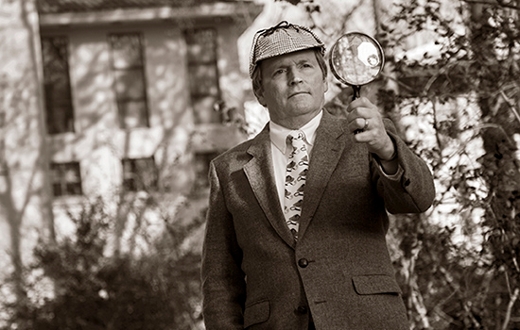Emory Special Diagnostic Services, first patient, Sept. 30, 2013:
A 65-year-old man being evaluated for a renal transplant was referred by the transplant team for a workup. The reason for the referral was unusual lesions on his CT scan, multiple pulmonary nodules, and abdominal lymphadenopathy. Biopsy result was sarcoidosis, a poorly understood disease.
Nearly three years after seeing their first patient, the Emory Special Diagnostic Services team is sitting around a long table in a conference room on the first floor of the Emory Clinic, discussing challenging cases.
"It's what inspires us, what we love," says Special Diagnostic Services director Clyde Partin.
The team, consisting of five doctors and one nurse navigator, holds these roundtables routinely. "It's always helpful to have more than one brain considering a patient's case," says Tom Jarrett, an internist at Emory Clinic. "We go in open-minded to all possibilities."
Emory Special Diagnostic Services, part of the Paul W. Seavey Comprehensive Internal Medicine Clinic, is one of a handful of such clinics around the country, dedicated to patients with complex, undiagnosed illnesses. The team has seen more than 200 patients since opening, about half of whom received diagnoses. "What people really want is an answer," says Partin, who is sometimes called "Emory's Dr. House" for his diagnostic acumen, a moniker that, while tongue-in-cheek, is not far off the mark.
To prepare for the Special Diagnostic clinic's opening, Partin and his team of Rollins Distinguished Clinicians reviewed diagnoses of House MD scripts from the long-running Fox series and analyzed Lisa Sanders's "Diagnosis" and "Think Like a Doctor" columns from the New York Times, many of which served as the basis for House episodes. They also reviewed the New England Journal of Medicine's first 200 case conferences from the 1920s as well as 200 modern cases from 2005 to 2007.
"It may not have been the most scientific approach, but we were curious about what sort of diagnoses were persistently perplexing," Partin says.
His own preparations included reading up on commonly missed diagnoses in outpatient settings, although he found the literature on this to be sparse and more focused on inpatient diagnoses.
"The subtle distinctions between missed diagnoses versus misdiagnoses can be vexing," he says. "Atypical presentations of common diseases are much more likely than typical presentations of rare disease. "
In other words, the medical adage, "When you hear hoofbeats, think horses, not zebras," holds true even for diagnostic clinics.
For each referred patient, the team requests existing medical records, imaging, and letters from previous doctors; takes a thorough medical and family history; and conducts a comprehensive physical examination, often with a variety of tests, new imaging, and tissue biopsies. Depending on the findings, Emory specialists from neurology to genetics are consulted.
"A lot of times, we know what it's not, but not what it is," says clinic internist Sharon Bergquist. Some of the seemingly mysterious cases brought before them are "just oversights from disjointed evaluations," she adds. "We take a second look to make sure that all elements of the patient's history are taken into consideration."
Often, even before coming to the clinic, the patients have seen multiple doctors and researched all of the horrible diseases that could possibly be related to their symptoms, courtesy of Google.
But symptoms, as Partin is fond of saying, do not a diagnosis make.
Unlike the patient cases handpicked for TV medical dramas, which are almost always neatly wrapped up by the end of the hour, "in the trenches of diagnostic clinics, answers waltz out of the closet less than half the time," he says. "That is one of the unfortunate realities of seeing the most difficult cases. There has to be a realistic willingness to accept failure."
The most common of the clinic's 100-plus diagnoses so far were neurologic (17), followed by circulatory, digestive, and musculoskeletal. There were nine mental health diagnoses. Eight patients died.

